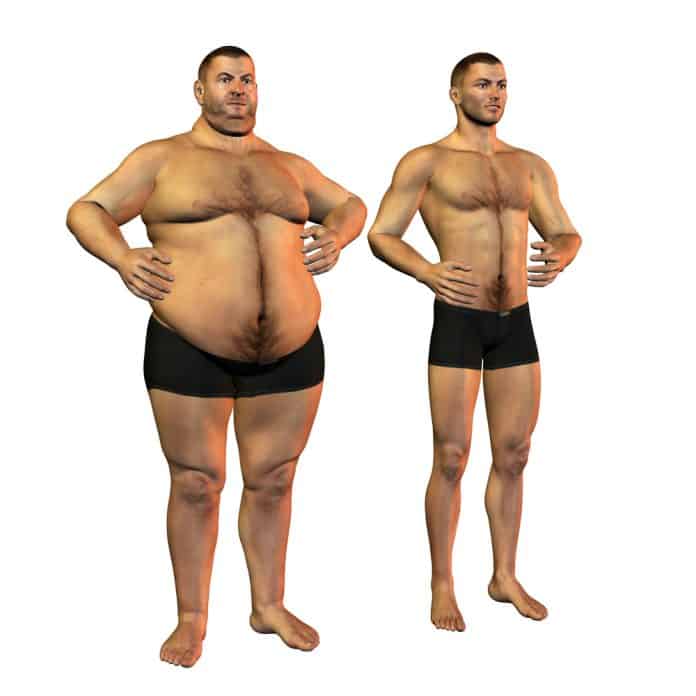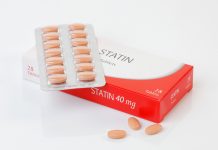Decreasing HIV Related Belly Fat Accumulation
In the mid-90s with the advent of the first antiretroviral (AVR) drug combination therapies, Kaposi’s sarcoma (KS) lesions and lipodystrophy (wasting away of body fat) rapidly faded from public consciousness as signs of HIV infection. Only to be replaced by another symptom that can powerfully impact the health and appearance and health of the HIV population: Belly fat accumulation, also called HIV-related lipohypertrophy.
As disfiguring and embarrassing as the gauntness that once afflicted so many battling this disease once was – many people living with HIV (PLWH) now have to find a way to deal with the unhealthy accumulation of belly fat. Let’s take a look at:
- What is HIV Lipohypertrophy?
- The health risks that come with it
- How to reduce belly fat with diet
- Reducing belly fat with exercise
- Supplements that could help
- Drugs that can be used to reduce belly fat
HIV Lipohypertrophy and Lipoatrophy
PLWH can experience HIV lipohypertrophy: Fat accumulation in their subcutaneous tissues (under the skin), within the abdominal cavity, and on the belly or behind the neck (creating a ‘buffalo hump’ appearance).Women may experience both gynecomastia and breast augmentation.
However, lipohypertrophy can also be accompanied by lipoatrophy (fat loss) in the face, arms, buttocks, and legs. Muscle atrophy and bone loss could also occur. Currently, there isn’t a consensus regarding definitions of the different kinds of lipoatrophy or lipohypertrophy, neither is there a reference test for the diagnosis (1).
Some of these symptoms could be caused by taking HIV medications, and some may be the result of the infection. Lipoatrophy is most frequent with drugs like d4T (Zerit, stavudine) and AZT (zidovudine, ZDV), which aren’t often prescribed in the US (2).
While the accumulation of belly fat is possibly an effect of HIV, it’s also been observed in PLWH who take protease inhibitors like indinavir (Crixivan), which is also rarely prescribed now (3).
Health Risks of Excess Belly Fat
The problem with HIV-related belly fat is that it isn’t limited to just the subcutaneous fat layer (fat located under the skin). Belly fat also includes visceral fat deep inside the abdomen and surrounding the internal organs.
Visceral fat is particularly dangerous because fat around the abdominal organs may not just swell the belly; it can also change the way the body functions (4).
Regardless of body weight, excess visceral fat may increase the risk of:
- Heart disease or stroke
- Dementia
- Type 2 diabetes
- Colorectal cancer
- Sleep apnea
- Early death from all causes
- Hypertension (high blood pressure)
Fat cells can do much more than store extra calories. Visceral fat tissue, in particular, can behave in an organ-like manner by secreting hormones and inflammatory substances called cytokines; leading to inflammation and interfering with the hormones regulating appetite, brain function, and weight (5).
Decrease HIV Related Belly Fat with Diet
One of the best approaches to dealing with HIV-related belly fat is by making changes to the diet. While calorie restriction alone can reduce belly fat accumulation – it can be hard to stick with long-term (6). Sufficiently reducing food intake to make an impact on body fat levels is typically uncomfortable and may also reduce muscle mass, slowing the resting metabolic rate (6). Calorie restriction may be a way to jump-start fat loss but isn’t optimal to maintain healthy body fat levels.
A better and long-term method of losing belly fat may be by reducing carbohydrate intake with a ketogenic diet.
The body has two sources of fuel; glycogen (sugar) and ketones (fatty acids). When someone consumes a steady supply of starches and sugars, the body does not need to tap into stored fat. A ketogenic diet is intended to deplete the body’s supply of glycogen so that it can begin breaking down the excess fat.
One of the greatest benefits of a ketogenic diet is that it can lead to a reduction in appetite (7). Studies consistently demonstrate that when people reduce carbohydrate intake and consume more protein and fat, they eat fewer total calories. When researchers compared ketogenic to low-fat dieting in recent studies, calories had to be restricted in the low-fat group to achieve comparable results (8).
Reduce Belly Fat by Doing HIIT
Getting regular exercise is a healthy habit and comes with many benefits. Unfortunately, reducing belly and visceral fat isn’t one of them. The amount of running, biking or swimming that someone performs to burn enough calories to significantly impact weight loss is extraordinary. To burn about 3500 calories (the amount in one pound of fat) the average person would need to run about 29 miles at a six mile per hour pace.
But, there is a training protocol that has been demonstrated to reduce body fat while building strength and cardiovascular fitness; high-intensity interval training (HIIT) (9).
HIIT is done by exercising in short bursts of all-out effort with brief rest periods between sets. Research has shown that HIIT is a time-efficient way to:
- Burn calories in a shorter amount of time
- Boost the metabolism
- Lose fat without losing muscle
- Improve cardiovascular health
Research shows that only 15 minutes of HIIT training can burn more calories than one-hour on a treadmill (9). HIIT workouts can also utilize body weight exercises, so a workout that gets your heart rate up fast like sprinting, jumping jacks, and Burpees can be used for a HIIT workout almost anywhere.
Supplements that Help Reduce Abdominal Fat
Weight loss supplements have a (well-deserved) bad reputation. But certain vitamins and other substances found in nature, when taken while eating a healthy diet and following an exercise routine, could help reduce HIV-related belly fat.
Whey protein: Overweight test-subjects who consumed one whey protein drink per day lost more weight than those who had a daily soy protein shake instead, according to a study published in the Journal of Nutrition (10).
Green tea extract: A study in the European Journal of Clinical Nutrition (11) found that at low doses, a phytochemical in green tea called epigallocatechin gallate can increase fat oxidation by approximately 33 percent.
Glutamine: A study in European Journal of Clinical Nutrition (12) concluded that without reducing caloric intake people still lost weight after taking a glutamine supplement for one month.
Vitamin D: A 2009 study from the University of Minnesota (13) found that individuals who begin a diet with healthy vitamin D levels lost more weight than those who dieted with low vitamin D levels.
Drugs that may be Used to Shrink Belly Fat
Metformin (Glucophage): According to one study (14), weight loss from metformin will tend to happen slowly over a couple of years. The amount of weight lost can also vary between individuals. In this study, the average weight loss after two or more years was between four and seven pounds.
Testosterone: Low testosterone levels have been associated with higher levels of body fat. According to one study – long-term testosterone therapy in men with testosterone deficiency produces significant and sustained weight loss and a marked reduction in waist size (15).
Appetite suppressants: Common prescription appetite suppressants like orlistat, Belviq, Contrave, Saxenda, phentermine, and Qsymia may help reduce HIV-related body fat through calorie restriction (16). A patient will typically need to have a body mass index (BMI) over 27 or have a weight-related condition such as diabetes or hypertension before the doctor will provide a prescription (16).
Egrifta: Egrifta is the first drug approved to reduce the accumulation of HIV-related belly fat. It works as a synthetic analog of human growth hormone-releasing hormone and stimulates the production and release of the body’s natural growth hormone to reduce body fat levels (17).
Oxandrolone: Oxandrolone (Anavar, Oxandrin) is a mild anabolic steroid with low androgenic activity that also has low water retention properties. It will promote muscle mass gains while also helping to reduce body fat (18).
N-Acetylcysteine (NAC) and Glycine: Research demonstrates that combining NAC (a powerful antioxidant) with glycine can increase strength while significantly improving body composition in HIV patients. The data suggest that reduced glutathione (GSH) production caused by a deficiency of cysteine and glycine can be quickly corrected by supplementing with NAC and glycine. Increased levels of GSH is associated with lower body fat, reduced waist circumference, and more fat-free muscle mass and strength (19).
References
1) Baril, Jean-Guy et al. “HIV-Associated Lipodystrophy Syndrome: A Review of Clinical Aspects.” The Canadian Journal of Infectious Diseases & Medical Microbiology 16.4 (2005): 233–243. Print.
2) Montessori, Valentina et al. “Adverse Effects of Antiretroviral Therapy for HIV Infection.” CMAJ : Canadian Medical Association Journal 170.2 (2004): 229–238. Print.
3) Anuurad, Erdembileg, Andrew Bremer, and Lars Berglund. “HIV Protease Inhibitors and Obesity.” Current opinion in endocrinology, diabetes, and obesity 17.5 (2010): 478–485. PMC. Web. 7 Dec. 2017.
4) Saelens, Brian E et al. “Visceral Abdominal Fat Is Correlated with Whole-Body Fat and Physical Activity among 8-Y-Old Children at Risk of Obesity.” The American journal of clinical nutrition 85.1 (2007): 46–53. Print.
5) Grant, Ryan W., and Vishwa Deep Dixit. “Adipose Tissue as an Immunological Organ.” Obesity (Silver Spring, Md.) 23.3 (2015): 512–518. PMC. Web. 7 Dec. 2017.
6) Tomiyama, A. Janet et al. “Low Calorie Dieting Increases Cortisol.” Psychosomatic medicine 72.4 (2010): 357–364. PMC. Web. 7 Dec. 2017.
7) McClernon, F. J., Yancy, W. S., Eberstein, J. A., Atkins, R. C. and Westman, E. C. (2007), The Effects of a Low-Carbohydrate Ketogenic Diet and a Low-Fat Diet on Mood, Hunger, and Other Self-Reported Symptoms. Obesity, 15: 182. doi:10.1038/oby.2007.516
8) Krebs, Nancy F. et al. “Efficacy and Safety of a High Protein, Low Carbohydrate Diet for Weight Loss in Severely Obese Adolescents.” The Journal of pediatrics 157.2 (2010): 252–258. PMC. Web. 7 Dec. 2017.
9) Boutcher, Stephen H. “High-Intensity Intermittent Exercise and Fat Loss.” Journal of Obesity2011 (2011): 868305. PMC. Web. 7 Dec. 2017.
10) David J. Baer, Kim S. Stote, David R. Paul, G. Keith Harris, William V. Rumpler, and Beverly A. Clevidence. Whey Protein but Not Soy Protein Supplementation Alters Body Weight and Composition in Free-Living Overweight and Obese Adults. The Journal of Nutrtion. (2011).
11) Stephen Daniells. Green Tea Extract Effective for Weight Loss at Low Doses. Nutraingredients.com. (2010).
12) Laviano A, Molfino A, Lacaria MT, Canelli A, De Leo S, Preziosa I, Rossi Fanelli F. Glutamine supplementation favors weight loss in nondieting obese female patients. A pilot study. Eur J Clin Nutr. 2014 Nov;68(11):1264-6. doi: 10.1038/ejcn.2014.184. Epub 2014 Sep 17.
13) Medical News Today Staff. Link Between Successful Weight Loss And Vitamin D Levels. Medical News Today. (2009).
14) The Diabetes Prevention Program Research Group. “Long-Term Safety, Tolerability, and Weight Loss Associated With Metformin in the Diabetes Prevention Program Outcomes Study.” Diabetes Care 35.4 (2012): 731–737. PMC. Web. 7 Dec. 2017.
15) Traish AM. Testosterone and weight loss: the evidence. Curr Opin Endocrinol Diabetes Obes. 2014 Oct;21(5):313-22. doi: 10.1097/MED.0000000000000086.
16) Rodgers, R. John, Matthias H. Tschöp, and John P. H. Wilding. “Anti-Obesity Drugs: Past, Present and Future.” Disease Models & Mechanisms 5.5 (2012): 621–626. PMC. Web. 7 Dec. 2017.
17) Dhillon S. Tesamorelin: a review of its use in the management of HIV-associated lipodystrophy. Drugs. 2011 May 28;71(8):1071-91. doi: 10.2165/11202240-000000000-00000.
18) Lovejoy JC, Bray GA, Greeson CS, Klemperer M, Morris J, Partington C, Tulley R. Oral anabolic steroid treatment, but not parenteral androgen treatment, decreases abdominal fat in obese, older men. Int J Obes Relat Metab Disord. 1995 Sep;19(9):614-24.
19) Nguyen, Dan et al. “Effect of Increasing Glutathione With Cysteine and Glycine Supplementation on Mitochondrial Fuel Oxidation, Insulin Sensitivity, and Body Composition in Older HIV-Infected Patients.” The Journal of Clinical Endocrinology and Metabolism 99.1 (2014): 169–177. PMC. Web. 7 Dec. 2017.
************************************************** ***********
Question:
Nelson, I have HIV lipodystrophy (mostly accumulation of deep visceral belly fat). I exercise 4 times per week and watch what I eat but my belly does not come down. Any recommendations for me? My viral load is undetectable.
From Nelson:
Here is background information about lipodystrophy and its potential treatments:
HIV Lipodystrophy Options
If you want to lose fat fast follow a modified Atkins diet:
https://www.atkins.com/Program/Overview.aspx
Food plan booklet:
https://www.zelja.com/recepti/Atkinso…t%20Manual.pdf
There are 3 phases:
https://www.atkins.com/Program/Phase-…ion-Right.aspx
https://www.atkins.com/Program/Phase-2.aspx
https://www.atkins.com/Program/Phase-3.aspx
Recipes
https://www.atkins.com/Recipes.aspx
If a more moderate diet is preferred, follow these suggestions:
I have a few exercise suggestions here that can accelerate fat loss and lean body mass gain:
Nelson Vergel’s Time-Saving Tips to Maximize the Benefits of Exercise
Medications and Blood Tests:
1- Keep your total testosterone over 500 ng/dL (use testosterone replacement therapy if your T is low). Get your total and free testosterone here (No Doctor Visit-US Only)
2- Test your thyroid TSH, free T3, and free T4 to make sure your thyroid is working well. Low thyroid function can make it difficult to lose fat. You can obtain this panel cheaply here (in the US only): Thyroid Panel
2- Metformin at 500 mg twice per day with food may help burn fat. You need a prescription.
Watch my lecture on Metformin here
If you have insurance, get your doctor to prescribe Egrifta (note: This hormone product is only minimally effective but the only one FDA approved for HIV related belly fat)
The combo of Egrifta plus Metformin plus the diet and exercise may work synergistically but no studies have been performed with this quadruple intervention.
If you do not have insurance, Theratecnologies (makers of Egrifta) has a patient assistance program:
Sign up by calling 1-844-EGRIFTA (1-844-347-4382)
For those with no potential access to Egrifta, this is a combination of growth hormone release hormones/peptides that can be obtained via prescription:
GHRP-2 / GHRP-6 / SERMORELIN ACETATE INJECTION
Also, read this article I wrote for TheBody.com suggesting fat loss tips.
If you are using testosterone now, you may want to watch my latest video about the use of HCG with testosterone
Oxandrolone (Old brand names: Oxandrin, Anavar) has been shown to decrease subcutaneous and visceral fat while helping increase lean mass. 20- 40 mg per day is the usual dose.
If your insurance does not want to pay, you can get it by prescription out-of-pocket here:
OXANDROLONE CAPSULES
I hope this information helps!
Join my HIV discussion group by sending an email to [email protected]
There are over 3800 long-term survivors there!

















